Marc Tyler Nobleman's Blog, page 141
October 25, 2011
Pre-dawn interview on ABC
In Eastern Maryland for several speaking engagements on 10/3/11, I gave a short interview on ABC affiliate WMDT. It was all over by 6:20 a.m., so you will get a full serving of my morning voice.

Published on October 25, 2011 04:24
October 24, 2011
How schools enrich authors
On the first day of my two-week author visit to Guam, one of my hosts and I got to talking about Guam in literature. Apparently few authors hail from Guam, and no publishing companies are based there. That doesn't mean Guam isn't in stories. It means those stories are rarely originating from the people who know Guam best.
However, an author need not hail from a place about which he writes. Most writers are outsiders to at least some of their topics. One of the best ways to gain perspective on a place is to ask someone who is a stranger there.
It turns out Canadian-born YA novelist Gordon Korman was an author guest on Guam in the 1990s. He later used Guam as a setting in his Island trilogy (Shipwreck, Survival, Escape). This demonstrates a lovely point that did not occur to me until I was on Guam.
Schools bring in authors to enrich students. In doing so, the schools enrich the authors, too.
This is because schools are often exposing authors to settings they might otherwise never know firsthand, and some of these settings may inspire some aspect of a book. This in turn may enrich students again, but in a different way.
If not for school visits (and also conferences related to children's books), I might never have made it to Kansas, Wisconsin, Texas, Alabama, Tennessee, Washington State, or, yes, Guam.
Guam invites at least one author every year, and this not only provides a tremendous opportunity for both students and author but also increases the chances that an author will write about Guam. I don't know if I will be one of them, but either way I will be interested to see the results if someone else is.
And, of course, it may be an author visit that inspires a young person from Guam to become an author him/herself.
However, an author need not hail from a place about which he writes. Most writers are outsiders to at least some of their topics. One of the best ways to gain perspective on a place is to ask someone who is a stranger there.
It turns out Canadian-born YA novelist Gordon Korman was an author guest on Guam in the 1990s. He later used Guam as a setting in his Island trilogy (Shipwreck, Survival, Escape). This demonstrates a lovely point that did not occur to me until I was on Guam.
Schools bring in authors to enrich students. In doing so, the schools enrich the authors, too.
This is because schools are often exposing authors to settings they might otherwise never know firsthand, and some of these settings may inspire some aspect of a book. This in turn may enrich students again, but in a different way.
If not for school visits (and also conferences related to children's books), I might never have made it to Kansas, Wisconsin, Texas, Alabama, Tennessee, Washington State, or, yes, Guam.
Guam invites at least one author every year, and this not only provides a tremendous opportunity for both students and author but also increases the chances that an author will write about Guam. I don't know if I will be one of them, but either way I will be interested to see the results if someone else is.
And, of course, it may be an author visit that inspires a young person from Guam to become an author him/herself.
Published on October 24, 2011 00:00
October 22, 2011
Going, going, Guam, part 2 of 4
Part 1.
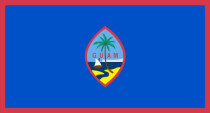 I'm halfway around the world and halfway through two weeks of author visits. The people of Guam are among the kindest and heartiest I've ever met in my professional travels.
I'm halfway around the world and halfway through two weeks of author visits. The people of Guam are among the kindest and heartiest I've ever met in my professional travels.
Here is a photo-recap of my first full working week on island; 14 schools down, 12 to go!
Greetings
"Hafa Adai" is "hello" in Chamorro, the language of the natives of Guam. The Hafa Adais I was treated to on Guam have been nothing short of spectacular.
Here are a few:
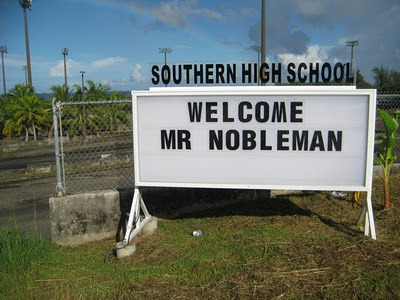 In seven years of author visits, this the first school whose sign backdrop
In seven years of author visits, this the first school whose sign backdrop
is the ocean. (It's that patch of dark blue beyond the palm trees—also a first.)
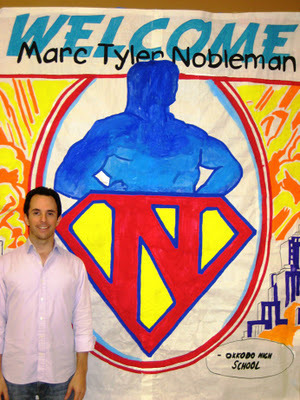 Another superlative: This vivid welcome sign is, I think,
Another superlative: This vivid welcome sign is, I think,
the tallest that kids have made for me.
[image error] Here's one of the longest!
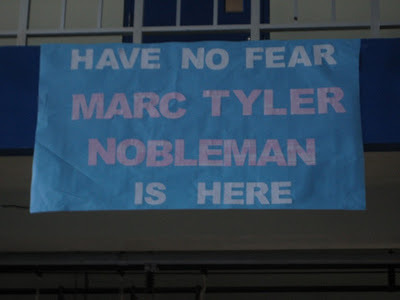 And one of the coolest. This was their play on my superhero work.
And one of the coolest. This was their play on my superhero work.
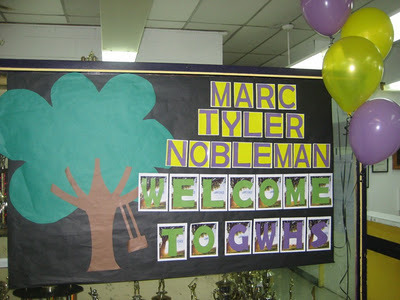 The two bottom rows of letters are on reproductions of the cover of
The two bottom rows of letters are on reproductions of the cover of
Vanished: True Stories of the Missing.
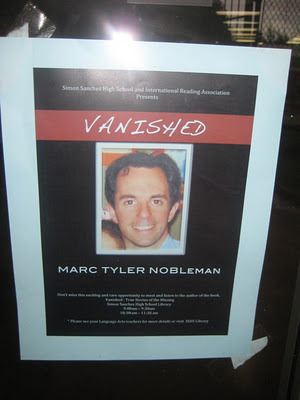 Speaking of Vanished, at first glance, this promotional flyer
Speaking of Vanished, at first glance, this promotional flyer
looks like another type of flyer...
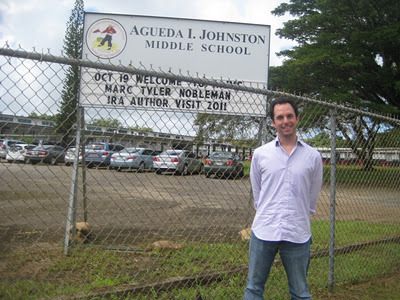 No good way around getting the fence in this photo.
No good way around getting the fence in this photo.
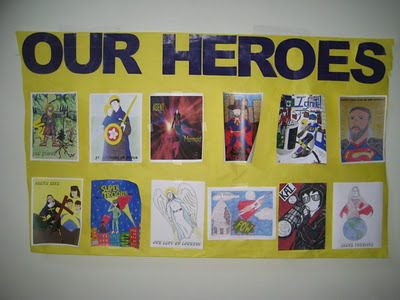 At one Catholic school, students had been asked to draw their heroes
At one Catholic school, students had been asked to draw their heroes
using a superhero motif. Some chose religious figures.
Island views
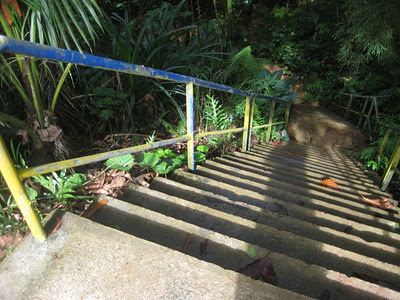 This staircase leads down to a peaceful jungle site that was once anything but;
This staircase leads down to a peaceful jungle site that was once anything but;
it's a WWII memorial to a squadron of Japanese who fought valiantly till the end.
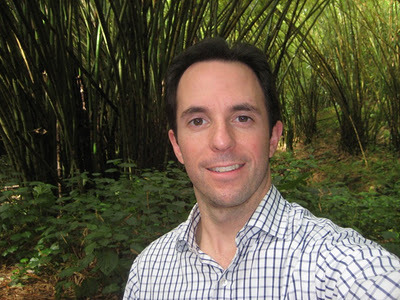 I am probably the first visitor ever to go there in
I am probably the first visitor ever to go there in
a long-sleeved, button-down shirt.
 Tranquil but haunting.
Tranquil but haunting.
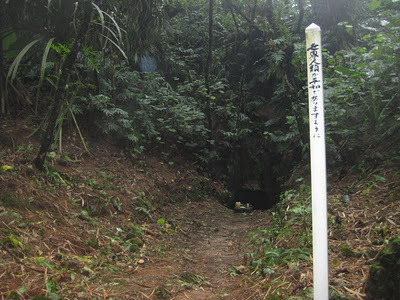 One of several caves Japanese soldiers hid in.
One of several caves Japanese soldiers hid in.
TV appearances
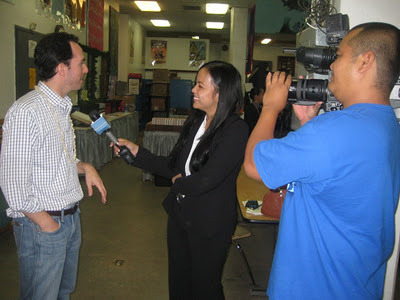
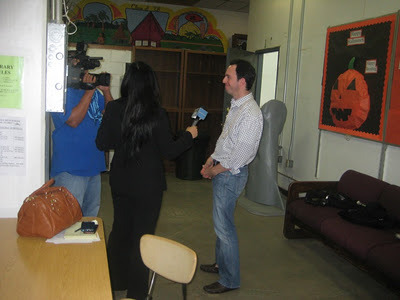 Above two photos: being interviewed by the
Above two photos: being interviewed by the
ABC affiliate that came to my first presentation.
Next few photos: filming a literacy Public Service Announcement
at the PBS affiliate. I even got to write it myself.
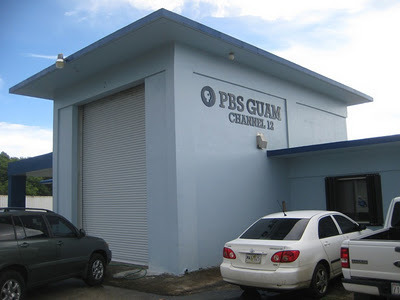
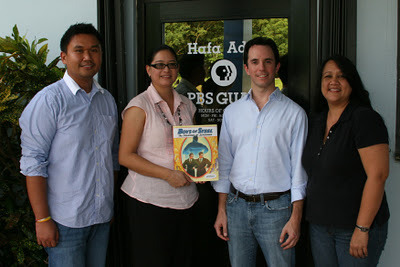 With two of my kind hosts from IRA (International Reading Association),
With two of my kind hosts from IRA (International Reading Association),
Jonathan and Nel (far right), and PBS producer Leigh.
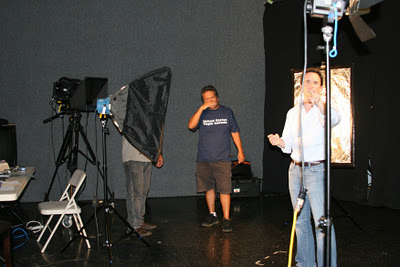
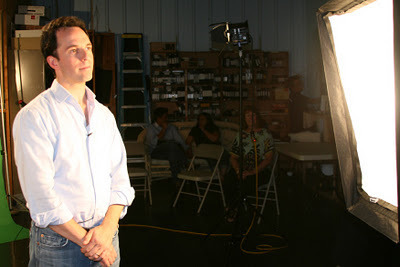
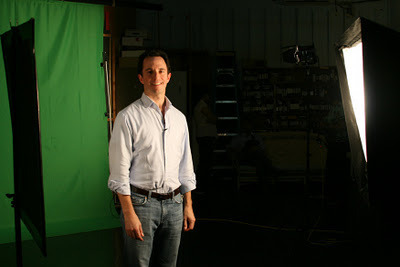 I had to stand in front of a green screen. I'm assuming they will use that
I had to stand in front of a green screen. I'm assuming they will use that
to somehow make me look less dorky.
[image error] They sold a lot of my books. The island-wide speed limit is 35
and, for added safety, this signed stack is being driven to
my next appearance in a car seat.
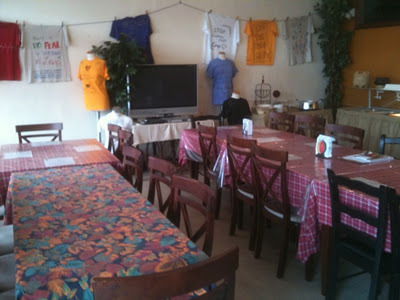
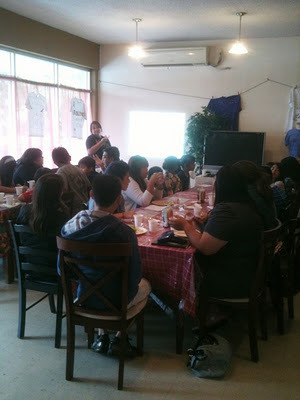 The two photos above are from my first-ever workshop held in a coffee shop;
The two photos above are from my first-ever workshop held in a coffee shop;
it was marketed to teens but everyone from tweens to adults attended.
It was a really great group.
Local color
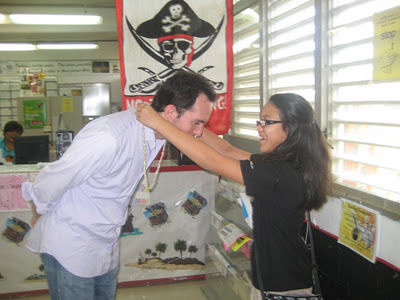 Most schools honored me by gifting me bountifully, including a necklace
Most schools honored me by gifting me bountifully, including a necklace
(variously made of shells, flowers, leaves, beads, or other island jewels).
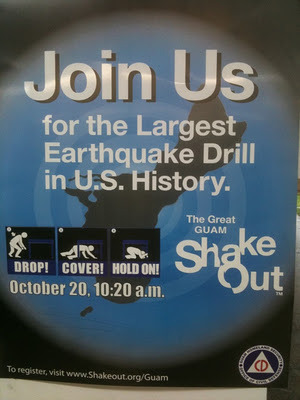 Guam is in an earthquake (and typhoon, and tsunami) zone.
Guam is in an earthquake (and typhoon, and tsunami) zone.
While I was there, the only one we had a drill for was
the first; luckily, we had no real emergencies.
[image error] The coconut crab (shown here) is the world's largest land arthropod,
if I'm remembering correctly without googling to doublecheck.
If one pinches you, it will not let go even if you pound on it.
I've heard two ways you can make it release:
tickling its soft undercarriage or
touching a burning match/object to its rear.
Neither sounds fun, but both sound more fun than
a huge crab permanently clamped onto your finger.
[image error] At one school, the color scheme of the room I spoke in was
so serene, I almost felt like I was underwater.
I believe this was the first time I'd seen a gym with a blue floor.
[image error]
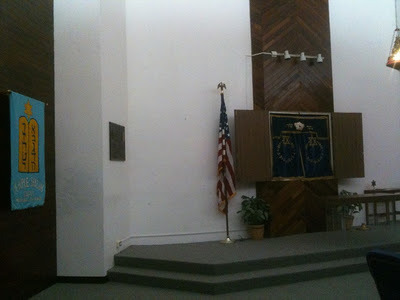 One of the two Friday nights I was on island, I attended the lone
One of the two Friday nights I was on island, I attended the lone
Jewish service available. It was on the naval base; the two photos above
show the sanctuary. In attendance: an active duty Coast Guard member
(the layperson who ran the service), the state archeologist,
a clown (no, not in costume), her two teenaged sons, and me.
Almost halfway to a cast of Survivor, and the right locale for it, too.
Bathrooms
 Another something I had not seen before: a sink with only a cold water knob.
Another something I had not seen before: a sink with only a cold water knob.
I'm told this is because Guam's climate is tropical. Some sinks did have
a hot water knob—but most of the ones I tried didn't work.
 This sink had not only a hot water option but also a
This sink had not only a hot water option but also a
built-in water fountain; however, I saw no others like this.
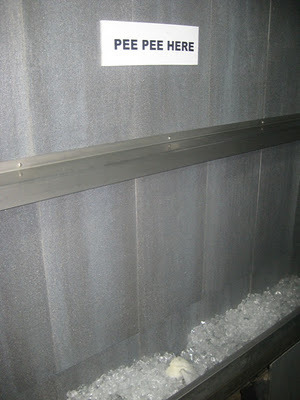 Another bathroom feature I saw only once:
Another bathroom feature I saw only once:
an ice-filled trough for—well, read the sign.
Highlights not covered by the pictures above:
Chickens were wandering everywhere. They belong to people but are allowed to roam free. Apparently they do come home to be fed.Cars last longer on Guam. Small island = low mileage (in proportion to the age of the car). Washers and dryers were often outside (though covered by an overhang).Not specific to Guam, but a reading teacher at one of the middle schools I spoke at told me she loved jazz artist Henry Grimes's story in Vanished...and she and her husband are now listening to his music.
Lastly, in the bay behind my hotel rises a small island; you can see it at the end of part 1 and will see it again in part 4. Though it seemed fairly far to me, I learned that during low tide, one can walk there.
So one day at 3:45 p.m., I put on my reef booties and did.
Outgoing took about 15 minutes; the way back felt longer, maybe because I was already wistful at the thought of abandoning "my" island. On the way there, the only living thing I saw in the clear water was a sea snake. When I arrived on the island, several kayakers were there, but they soon left, leaving me alone with the wee hermit crabs. I'd been told that this baby island was one of the best places on Guam to find nice shells, in part because it's one of the least trafficked. However, I searched an hour (including in the water) and did not find even one keeper.
En route back, as I was nearing the shore where my hotel was, a pregnant Korean woman at the water's edge was shouting to someone snorkeling a ways out. Turns out she spoke English and the person in the water was her husband; he could not, of course, hear her.
I volunteered to walk back out to him to let him know she wanted him. Normally, due to my aversion to both sand and midday sun, I am eager to get off a beach as soon as possible; in this case, with the tropical sunset and my little island still in view, I was happy to stay. (Pretending I was on a miniature "rescue" mission was also appealing. And delusional.)
Part 3.
 I'm halfway around the world and halfway through two weeks of author visits. The people of Guam are among the kindest and heartiest I've ever met in my professional travels.
I'm halfway around the world and halfway through two weeks of author visits. The people of Guam are among the kindest and heartiest I've ever met in my professional travels.Here is a photo-recap of my first full working week on island; 14 schools down, 12 to go!
Greetings
"Hafa Adai" is "hello" in Chamorro, the language of the natives of Guam. The Hafa Adais I was treated to on Guam have been nothing short of spectacular.
Here are a few:
 In seven years of author visits, this the first school whose sign backdrop
In seven years of author visits, this the first school whose sign backdropis the ocean. (It's that patch of dark blue beyond the palm trees—also a first.)
 Another superlative: This vivid welcome sign is, I think,
Another superlative: This vivid welcome sign is, I think,the tallest that kids have made for me.
[image error] Here's one of the longest!
 And one of the coolest. This was their play on my superhero work.
And one of the coolest. This was their play on my superhero work. The two bottom rows of letters are on reproductions of the cover of
The two bottom rows of letters are on reproductions of the cover of Vanished: True Stories of the Missing.
 Speaking of Vanished, at first glance, this promotional flyer
Speaking of Vanished, at first glance, this promotional flyerlooks like another type of flyer...
 No good way around getting the fence in this photo.
No good way around getting the fence in this photo. At one Catholic school, students had been asked to draw their heroes
At one Catholic school, students had been asked to draw their heroesusing a superhero motif. Some chose religious figures.
Island views
 This staircase leads down to a peaceful jungle site that was once anything but;
This staircase leads down to a peaceful jungle site that was once anything but;it's a WWII memorial to a squadron of Japanese who fought valiantly till the end.
 I am probably the first visitor ever to go there in
I am probably the first visitor ever to go there ina long-sleeved, button-down shirt.
 Tranquil but haunting.
Tranquil but haunting. One of several caves Japanese soldiers hid in.
One of several caves Japanese soldiers hid in.TV appearances

 Above two photos: being interviewed by the
Above two photos: being interviewed by theABC affiliate that came to my first presentation.
Next few photos: filming a literacy Public Service Announcement
at the PBS affiliate. I even got to write it myself.

 With two of my kind hosts from IRA (International Reading Association),
With two of my kind hosts from IRA (International Reading Association),Jonathan and Nel (far right), and PBS producer Leigh.


 I had to stand in front of a green screen. I'm assuming they will use that
I had to stand in front of a green screen. I'm assuming they will use thatto somehow make me look less dorky.
[image error] They sold a lot of my books. The island-wide speed limit is 35
and, for added safety, this signed stack is being driven to
my next appearance in a car seat.

 The two photos above are from my first-ever workshop held in a coffee shop;
The two photos above are from my first-ever workshop held in a coffee shop;it was marketed to teens but everyone from tweens to adults attended.
It was a really great group.
Local color
 Most schools honored me by gifting me bountifully, including a necklace
Most schools honored me by gifting me bountifully, including a necklace(variously made of shells, flowers, leaves, beads, or other island jewels).
 Guam is in an earthquake (and typhoon, and tsunami) zone.
Guam is in an earthquake (and typhoon, and tsunami) zone.While I was there, the only one we had a drill for was
the first; luckily, we had no real emergencies.
[image error] The coconut crab (shown here) is the world's largest land arthropod,
if I'm remembering correctly without googling to doublecheck.
If one pinches you, it will not let go even if you pound on it.
I've heard two ways you can make it release:
tickling its soft undercarriage or
touching a burning match/object to its rear.
Neither sounds fun, but both sound more fun than
a huge crab permanently clamped onto your finger.
[image error] At one school, the color scheme of the room I spoke in was
so serene, I almost felt like I was underwater.
I believe this was the first time I'd seen a gym with a blue floor.
[image error]
 One of the two Friday nights I was on island, I attended the lone
One of the two Friday nights I was on island, I attended the loneJewish service available. It was on the naval base; the two photos above
show the sanctuary. In attendance: an active duty Coast Guard member
(the layperson who ran the service), the state archeologist,
a clown (no, not in costume), her two teenaged sons, and me.
Almost halfway to a cast of Survivor, and the right locale for it, too.
Bathrooms
 Another something I had not seen before: a sink with only a cold water knob.
Another something I had not seen before: a sink with only a cold water knob.I'm told this is because Guam's climate is tropical. Some sinks did have
a hot water knob—but most of the ones I tried didn't work.
 This sink had not only a hot water option but also a
This sink had not only a hot water option but also abuilt-in water fountain; however, I saw no others like this.
 Another bathroom feature I saw only once:
Another bathroom feature I saw only once:an ice-filled trough for—well, read the sign.
Highlights not covered by the pictures above:
Chickens were wandering everywhere. They belong to people but are allowed to roam free. Apparently they do come home to be fed.Cars last longer on Guam. Small island = low mileage (in proportion to the age of the car). Washers and dryers were often outside (though covered by an overhang).Not specific to Guam, but a reading teacher at one of the middle schools I spoke at told me she loved jazz artist Henry Grimes's story in Vanished...and she and her husband are now listening to his music.
Lastly, in the bay behind my hotel rises a small island; you can see it at the end of part 1 and will see it again in part 4. Though it seemed fairly far to me, I learned that during low tide, one can walk there.
So one day at 3:45 p.m., I put on my reef booties and did.
Outgoing took about 15 minutes; the way back felt longer, maybe because I was already wistful at the thought of abandoning "my" island. On the way there, the only living thing I saw in the clear water was a sea snake. When I arrived on the island, several kayakers were there, but they soon left, leaving me alone with the wee hermit crabs. I'd been told that this baby island was one of the best places on Guam to find nice shells, in part because it's one of the least trafficked. However, I searched an hour (including in the water) and did not find even one keeper.
En route back, as I was nearing the shore where my hotel was, a pregnant Korean woman at the water's edge was shouting to someone snorkeling a ways out. Turns out she spoke English and the person in the water was her husband; he could not, of course, hear her.
I volunteered to walk back out to him to let him know she wanted him. Normally, due to my aversion to both sand and midday sun, I am eager to get off a beach as soon as possible; in this case, with the tropical sunset and my little island still in view, I was happy to stay. (Pretending I was on a miniature "rescue" mission was also appealing. And delusional.)
Part 3.
Published on October 22, 2011 23:36
October 21, 2011
Trying to landmark a Bill Finger building in NYC
There is no permanent tribute to Batman in New York, the city in which he was created.
As far as I know, there is no tribute to any superhero in New York, the city in which many of them were created—the unofficial superhero capital of the world.
(Nationwide, the only memorials to superheroes that I know of are for Superman—Metropolis, IL boasts a large statue and Cleveland, where Superman was created, is home to a historical marker and recently installed commemorations at the sites of the former homes of Jerry Siegel and Joe Shuster.)
Though the superhero most commonly associated with New York City is probably Spider-Man, Batman predates him by more than 20 years and his Gotham City is clearly a New York analog. Therefore, I feel that the first superhero memorial in New York (and it's inevitable that there will be some) should be for Batman.
And naturally, I feel Bill Finger should be the focus. (At the least, the impetus.)
So I proposed it.
Of the various buildings in which Bill lived throughout Manhattan and the Bronx, I felt the one to start with was the building that housed his Grove Street apartment.
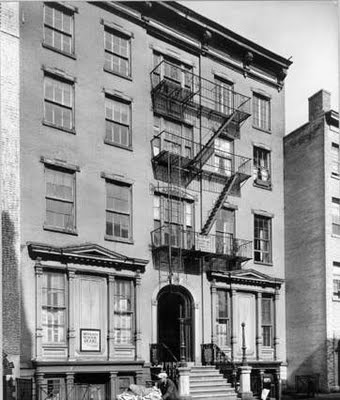 Bill's Grove Street building in 1935, roughly eight years before he moved in;
Bill's Grove Street building in 1935, roughly eight years before he moved in;
source: Museum of the City of New York
It wasn't where he lived when he co-created Batman. Or Robin. Or Joker. But in my mind, and in the minds of some of Bill's peers whom I interviewed, this apartment is "vintage Finger." He loved Greenwich Village and it was probably quite an exotic departure for him to move there from the Bronx. He lived on Grove during Batman's early success, from late 1943 or 1944 to 1950, during which time he did create the Riddler.
There are distinctions between landmarks, heritage sites, and likely other historical designations, but I'm not informed enough to discuss them. This much I did absorb: that entire neighborhood is already landmarked, meaning no buildings within it can be individually landmarked.
However, that wouldn't preclude putting up a plaque. As such, I was directed to the company that owns the building and spoke with a kind man named Alex. (The Landmarks Preservation Commission must approve the location, design, and content of a plaque, but the owner of a building must first approve having a plaque.)
Alex knew of the building's connection to John Wilkes Booth but (unsurprisingly) not of its connection to Bill Finger. He wrote "If we are going to place a plaque, it would also be helpful to combine the more important historical details on the building together with the Batman details."
Though various notables have indeed passed through the building, I inferred he was referring primarily to Wilkes Booth.
In my proposal, I'd written, "I believe the Batman connection is [more significant than the Wilkes Booth one] because Finger was not a visitor—he actually lived in the building. And as of now, there are no other Batman commemorations in New York, so if we were to install a plaque at your Grove Street building, it would be Batman fan destination #1." In other words, I felt that a potential plaque doesn't need to include the building's other history to be worthwhile.
I sent additional info to hopefully further explain Finger's impact. I acknowledged that he's no Lincoln, but emphasized that Batman has had as much influence on our culture as a fictional character can.
In early July 2011, which was about two months after first contact, Alex and I spoke again. He said his kids had Googled me and were excited about my proposal, even suggesting that the laundromat currently occupying the bottom level of the building be converted into a Batman store. (I'm all for that.)
This seemed positive.
But the problem, he told me, is that it's a residential neighborhood already crowded by tourists, and the owners don't want to encroach upon their residents' privacy. He did ask where I envisioned placing a plaque but was able to shoot down each of my suggestions. (Street-level stairposts—they have six or eight sides which are too small for a plaque. Stairs—if people trip trying to read it, they could sue. Front door—people need to take the stairs to get to the front door. You get the idea.)
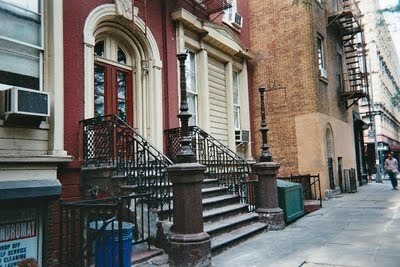 What is the word for such a post with six sides? Hexagonical? No, a hexagonal prism.
What is the word for such a post with six sides? Hexagonical? No, a hexagonal prism.
His suggestion was to contact the block association to ask if we could install something on the window box on the corner. That seemed weak tea to me but in case it was my last option, I did leave the block association president a voice mail. He didn't call back.
I tried one more time with the building owner, trying with all my passion to convey the grander reasons for agreeing to this relatively small gesture.
His response: "We have made our final decision. It is not workable for us to have any kind of plaque in front of the building."
I have begun to inquire elsewhere with promising results.
As far as I know, there is no tribute to any superhero in New York, the city in which many of them were created—the unofficial superhero capital of the world.
(Nationwide, the only memorials to superheroes that I know of are for Superman—Metropolis, IL boasts a large statue and Cleveland, where Superman was created, is home to a historical marker and recently installed commemorations at the sites of the former homes of Jerry Siegel and Joe Shuster.)
Though the superhero most commonly associated with New York City is probably Spider-Man, Batman predates him by more than 20 years and his Gotham City is clearly a New York analog. Therefore, I feel that the first superhero memorial in New York (and it's inevitable that there will be some) should be for Batman.
And naturally, I feel Bill Finger should be the focus. (At the least, the impetus.)
So I proposed it.
Of the various buildings in which Bill lived throughout Manhattan and the Bronx, I felt the one to start with was the building that housed his Grove Street apartment.
 Bill's Grove Street building in 1935, roughly eight years before he moved in;
Bill's Grove Street building in 1935, roughly eight years before he moved in;source: Museum of the City of New York
It wasn't where he lived when he co-created Batman. Or Robin. Or Joker. But in my mind, and in the minds of some of Bill's peers whom I interviewed, this apartment is "vintage Finger." He loved Greenwich Village and it was probably quite an exotic departure for him to move there from the Bronx. He lived on Grove during Batman's early success, from late 1943 or 1944 to 1950, during which time he did create the Riddler.
There are distinctions between landmarks, heritage sites, and likely other historical designations, but I'm not informed enough to discuss them. This much I did absorb: that entire neighborhood is already landmarked, meaning no buildings within it can be individually landmarked.
However, that wouldn't preclude putting up a plaque. As such, I was directed to the company that owns the building and spoke with a kind man named Alex. (The Landmarks Preservation Commission must approve the location, design, and content of a plaque, but the owner of a building must first approve having a plaque.)
Alex knew of the building's connection to John Wilkes Booth but (unsurprisingly) not of its connection to Bill Finger. He wrote "If we are going to place a plaque, it would also be helpful to combine the more important historical details on the building together with the Batman details."
Though various notables have indeed passed through the building, I inferred he was referring primarily to Wilkes Booth.
In my proposal, I'd written, "I believe the Batman connection is [more significant than the Wilkes Booth one] because Finger was not a visitor—he actually lived in the building. And as of now, there are no other Batman commemorations in New York, so if we were to install a plaque at your Grove Street building, it would be Batman fan destination #1." In other words, I felt that a potential plaque doesn't need to include the building's other history to be worthwhile.
I sent additional info to hopefully further explain Finger's impact. I acknowledged that he's no Lincoln, but emphasized that Batman has had as much influence on our culture as a fictional character can.
In early July 2011, which was about two months after first contact, Alex and I spoke again. He said his kids had Googled me and were excited about my proposal, even suggesting that the laundromat currently occupying the bottom level of the building be converted into a Batman store. (I'm all for that.)
This seemed positive.
But the problem, he told me, is that it's a residential neighborhood already crowded by tourists, and the owners don't want to encroach upon their residents' privacy. He did ask where I envisioned placing a plaque but was able to shoot down each of my suggestions. (Street-level stairposts—they have six or eight sides which are too small for a plaque. Stairs—if people trip trying to read it, they could sue. Front door—people need to take the stairs to get to the front door. You get the idea.)
 What is the word for such a post with six sides? Hexagonical? No, a hexagonal prism.
What is the word for such a post with six sides? Hexagonical? No, a hexagonal prism.His suggestion was to contact the block association to ask if we could install something on the window box on the corner. That seemed weak tea to me but in case it was my last option, I did leave the block association president a voice mail. He didn't call back.
I tried one more time with the building owner, trying with all my passion to convey the grander reasons for agreeing to this relatively small gesture.
His response: "We have made our final decision. It is not workable for us to have any kind of plaque in front of the building."
I have begun to inquire elsewhere with promising results.
Published on October 21, 2011 04:00
October 19, 2011
"Moneyball" and Bookball
In Moneyball, the nonfiction book by Michael Lewis and now a major motion picture starring Brad Pitt, a character believes pro baseball teams should buy wins not by buying players but by buying runs.
The most talented baseball players, naturally, command the highest salary. The budget of the Oakland A's is far lower than that of the New York Yankees. Therefore, the Yankees can afford players considered "better" than what the A's can afford. So how can a poorer team like the A's compete? How they can ever conquer?
By dividing.
I'm wobbly at both baseball and math, but here's how I understand it (using hypothetical figures): Instead of shelling out, say, $7 million, for a star player, a team of less means could pay three average players $250,000 each. It's okay if none of those three individually gets as many runs as the $7 million player—as long as collectively they do. So a team would be bringing in the same number of runs using three people instead of one—but for a fraction of the cost.
Baseball purists and long-timers saw this Moneyball model as controversial, absurd, or both. Yet it appears that it works, at least enough of the time for it to be taken seriously.
I see a parallel for the publishing industry. More and more, publishers want books that come with a brand—an already-famous name (i.e. Madonna) or company (i.e. Food Network) or blog (Stuff White People Like).
But brands are fallible. Not every book with a built-in brand does brisk business. I feel publishers often overlook something that can be more valuable than a brand.
To put this in Moneyball terms, I feel editors should buy books not by buying brands but by buying platforms. In other words, a great book by an unknown who promotes could be a better investment than an average book by a star.
What I mean by "platform" (and this may differ than how others use the word) is a position from which to generate excitement. It's best if you start with a great book, but even if you don't, and you're a great promoter, you may still have a winner. (Please note: I am not advocating weak books; I am simply emphasizing the power of promotion.)
In our iWorld, so much of a platform comes from social media, but it shouldn't end with that. There still is—and will always be—much to gain from in-person promotion. Writers who are committed to speaking and appearing at events related to their work have an advantage that social media doesn't provide: it's easier to charm face-to-face.
Another advantage to live promotion, particularly for authors of books for young people who speak in schools, is that when we put on our speaker hats, we almost always have a captive audience. In the case of school visits, the kids are forced to sit on that gym floor and listen to me whether or not they would choose to otherwise. Many kids have not heard of me beforehand, but my presentation may win them over to the point that they would then want one of my books that they would normally not notice. As a good number of other children's authors have discovered, you can typically sell more books after you present.
Let's recap:
Moneyball—buy wins by buying runs, not players
Bookball—buy books by buying platforms, not brands
In Moneyball, the underdog was hindered by a lack of funds. In Bookball, the underdog is hindered by a lack of fame. In either case, there are cost-effective (if not outright profitable) ways to circumvent these obstacles.
I feel publishers must consider an author's promotional conviction as an asset just as they do lyrical writing, a sticky premise, or a memorable main character. If you write a great book and you are dedicated to promoting it for the long haul, you may find that your platform has become a brand.
The most talented baseball players, naturally, command the highest salary. The budget of the Oakland A's is far lower than that of the New York Yankees. Therefore, the Yankees can afford players considered "better" than what the A's can afford. So how can a poorer team like the A's compete? How they can ever conquer?
By dividing.
I'm wobbly at both baseball and math, but here's how I understand it (using hypothetical figures): Instead of shelling out, say, $7 million, for a star player, a team of less means could pay three average players $250,000 each. It's okay if none of those three individually gets as many runs as the $7 million player—as long as collectively they do. So a team would be bringing in the same number of runs using three people instead of one—but for a fraction of the cost.
Baseball purists and long-timers saw this Moneyball model as controversial, absurd, or both. Yet it appears that it works, at least enough of the time for it to be taken seriously.
I see a parallel for the publishing industry. More and more, publishers want books that come with a brand—an already-famous name (i.e. Madonna) or company (i.e. Food Network) or blog (Stuff White People Like).
But brands are fallible. Not every book with a built-in brand does brisk business. I feel publishers often overlook something that can be more valuable than a brand.
To put this in Moneyball terms, I feel editors should buy books not by buying brands but by buying platforms. In other words, a great book by an unknown who promotes could be a better investment than an average book by a star.
What I mean by "platform" (and this may differ than how others use the word) is a position from which to generate excitement. It's best if you start with a great book, but even if you don't, and you're a great promoter, you may still have a winner. (Please note: I am not advocating weak books; I am simply emphasizing the power of promotion.)
In our iWorld, so much of a platform comes from social media, but it shouldn't end with that. There still is—and will always be—much to gain from in-person promotion. Writers who are committed to speaking and appearing at events related to their work have an advantage that social media doesn't provide: it's easier to charm face-to-face.
Another advantage to live promotion, particularly for authors of books for young people who speak in schools, is that when we put on our speaker hats, we almost always have a captive audience. In the case of school visits, the kids are forced to sit on that gym floor and listen to me whether or not they would choose to otherwise. Many kids have not heard of me beforehand, but my presentation may win them over to the point that they would then want one of my books that they would normally not notice. As a good number of other children's authors have discovered, you can typically sell more books after you present.
Let's recap:
Moneyball—buy wins by buying runs, not players
Bookball—buy books by buying platforms, not brands
In Moneyball, the underdog was hindered by a lack of funds. In Bookball, the underdog is hindered by a lack of fame. In either case, there are cost-effective (if not outright profitable) ways to circumvent these obstacles.
I feel publishers must consider an author's promotional conviction as an asset just as they do lyrical writing, a sticky premise, or a memorable main character. If you write a great book and you are dedicated to promoting it for the long haul, you may find that your platform has become a brand.
Published on October 19, 2011 04:27
October 18, 2011
Going, going, Guam, part 1 of 4
 On 10/12/11, I flew the three hours from Maryland to Houston. Then six hours to Honolulu. Then seven hours to Guam. Then 10 minutes from the airport to a hotel, but that was by car. All told, it is the farthest away I've ever been.
On 10/12/11, I flew the three hours from Maryland to Houston. Then six hours to Honolulu. Then seven hours to Guam. Then 10 minutes from the airport to a hotel, but that was by car. All told, it is the farthest away I've ever been.And naturally, that means that I am experiencing a world unlike any I've seen before.
This two-week engagement will include presentations at 26 schools, a library talk, a teen writing workshop, a teacher workshop, two radio interviews, and the filming of a PBS public service announcement to encourage reading. Plus snorkeling and, time permitting, learning how to husk a coconut.
However, my hosts scheduled no presentations for my first full day; instead, they toured me around the island from 8 a.m. to 5 p.m. That was a long day and the island is relatively small (30 miles long, 12 miles wide at its widest), but there were still areas I was left wanting to see.
Here are highlights of what I have seen/done so far:
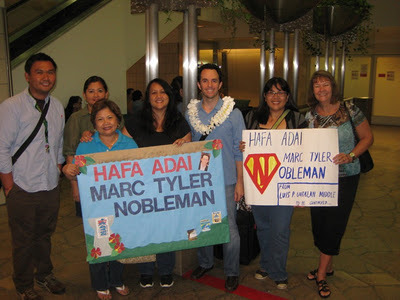 My warm (and well-attended) airport welcome!
My warm (and well-attended) airport welcome!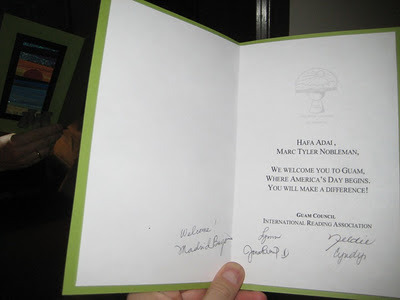 The warm welcome (print edition).
The warm welcome (print edition).I love the Guam slogan "Where America's Day Begins."
I also love their confidence in believing I will make a difference.
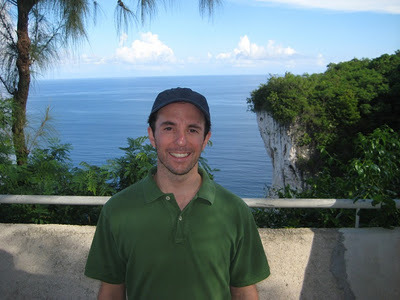 Two Lovers Point is the legendary site of an ancient young couple
Two Lovers Point is the legendary site of an ancient young couplewho tied their hair together and jumped from a cliff
rather than be forced apart by the societal rules of the time.
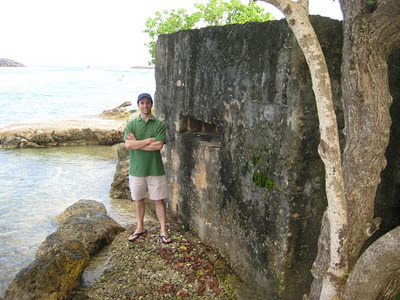 The island is lousy with abandoned Japanese bunkers from WWII.
The island is lousy with abandoned Japanese bunkers from WWII.You can even enter some—no admission fee, no safety barricade,
no accompanying gift shop. Also no light and no guarantee that
you won't encounter something creepy-crawly.
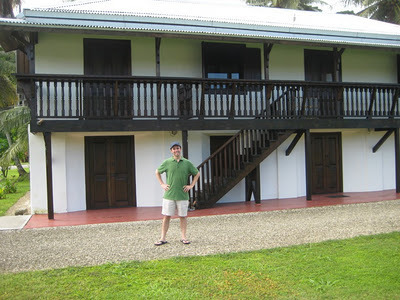 One of only two (or possibly three) prewar homes still standing
One of only two (or possibly three) prewar homes still standingon the island (which was heavily bombed during WWII).
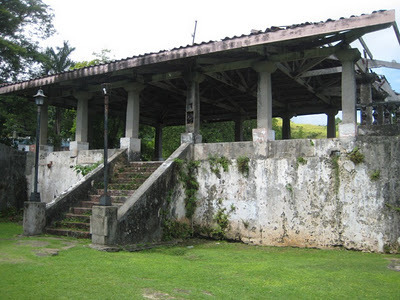 Before the Japanese and Americans (but after the native Chamorros),
Before the Japanese and Americans (but after the native Chamorros),the Spanish occupied Guam. Remnants of a lavish palace complex
still stand, though much of it is in disrepair.
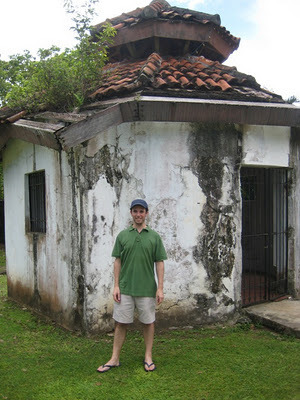 This is a "chocolate house." No, chocolate was not made inside.
This is a "chocolate house." No, chocolate was not made inside.People would go there for the equivalent of afternoon tea.
Today, it is home to a homeless person, whose shopping carts
and sleeping bag were strategically not visible to take this photo.
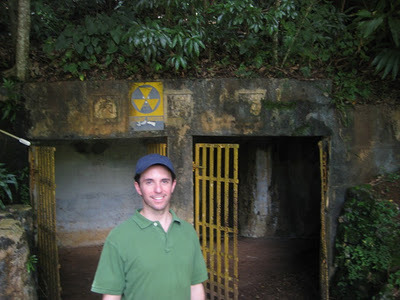 Above the doors of this bunker are three Japanese symbols
Above the doors of this bunker are three Japanese symbols(whose meaning I don't know), plus a fallout shelter sign.
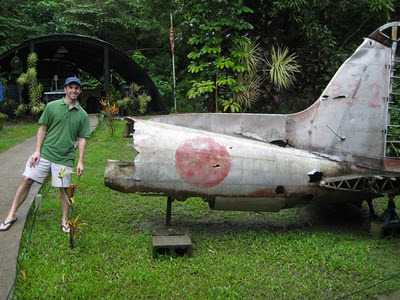 Appropriate timing: I got to see this and other WWII-era
Appropriate timing: I got to see this and other WWII-eraJapanese artifacts within two weeks of going public with my pitch
for my nonfiction picture book involving a WWII Japanese pilot.
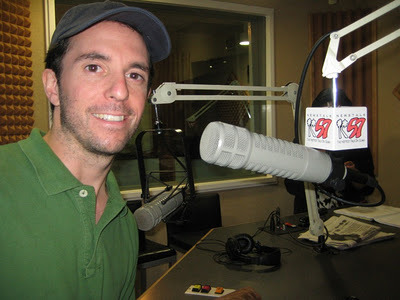 I did an hourlong radio interview (though two others were part of it,
I did an hourlong radio interview (though two others were part of it,so luckily for whoever was listening, I didn't talk the whole time).
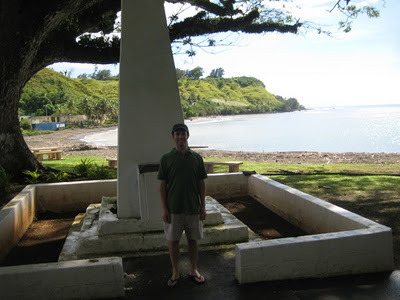 Magellan landed here.
Magellan landed here. 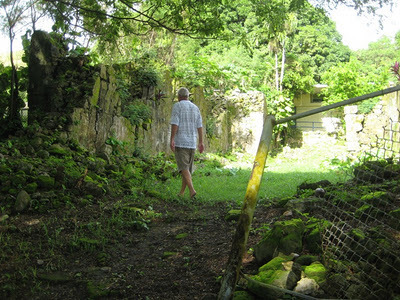 These 17th century Spanish church ruins are the
These 17th century Spanish church ruins are theoldest manmade structure on Guam.
[image error] My hosts think these trees inspired Dr. Seuss, who was apparently
on Guam during or shortly after the war.
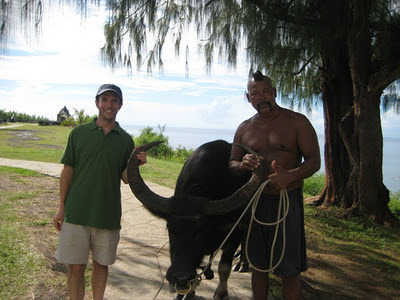 Carabao, a kind of domesticated water buffalo, graze the island
Carabao, a kind of domesticated water buffalo, graze the island(under care of humans). This one, his owner, and I became fast friends.
More scenery:
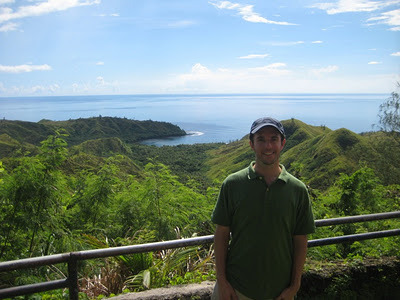
[image error] On 10/15/11, I was the speaker at the International Reading Association Guam Council meeting.
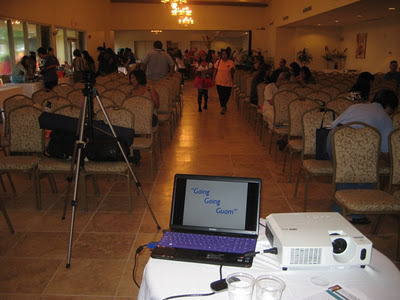 The audience of more than 150 was hearty and fun. You can see that I have repurposed the name of my presentation. You can also see that they weren't kidding when they said I'd be signing a lot of books; this is a partial showing:
The audience of more than 150 was hearty and fun. You can see that I have repurposed the name of my presentation. You can also see that they weren't kidding when they said I'd be signing a lot of books; this is a partial showing: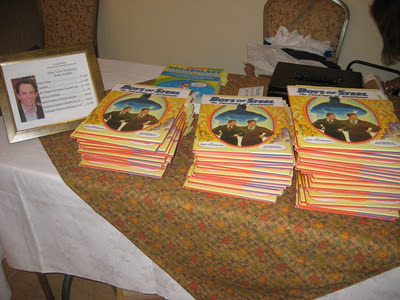 And this was only the first presentation day of two weeks.
And this was only the first presentation day of two weeks.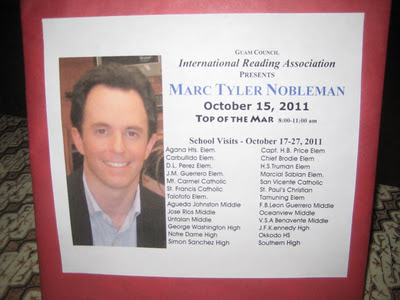
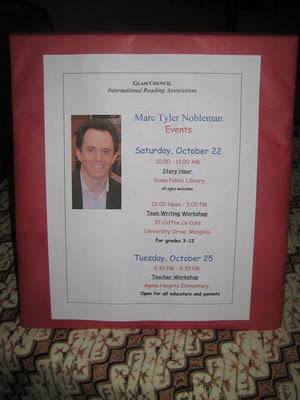 This time of year, the sun sets around 6 p.m. on Guam, which is far earlier than I was anticipating.
This time of year, the sun sets around 6 p.m. on Guam, which is far earlier than I was anticipating.[image error] But just as gorgeous as I was anticipating.
 Part 2.
Part 2.
Published on October 18, 2011 04:25
Going, going, Guam, part 1
 On 10/12/11, I flew the three hours from Maryland to Houston. Then six hours to Honolulu. Then seven hours to Guam. Then 10 minutes from the airport to a hotel, but that was by car. All told, it was the farthest away I'd ever been.
On 10/12/11, I flew the three hours from Maryland to Houston. Then six hours to Honolulu. Then seven hours to Guam. Then 10 minutes from the airport to a hotel, but that was by car. All told, it was the farthest away I'd ever been.And naturally, that meant that I am experiencing a world unlike any I've seen before.
This two-week engagement will include 14 schools, a library talk, a teen writing workshop, a teacher workshop, a radio interview, and the filming of a PBS public service announcement to encourage reading. Plus snorkeling and, time permitting, learning how to husk a coconut.
However, my hosts scheduled no presentations for my first full day; instead, they toured me around the island from 8 a.m. to 5 p.m. That was a long day and the island is relatively small (30 miles long, 12 miles wide at its widest), but there were still areas I was left wanting to see.
Here are highlights of what I have seen/done so far:
 My warm (and well-attended) airport welcome!
My warm (and well-attended) airport welcome! The warm welcome (print edition).
The warm welcome (print edition).I love the Guam slogan "Where America's Day Begins."
I also love their confidence in believing I will make a difference.
 Two Lovers Point is the legendary site of an ancient young couple
Two Lovers Point is the legendary site of an ancient young couplewho tied their hair together and jumped from a cliff
rather than be forced apart by the societal rules of the time.
 The island is lousy with abandoned Japanese bunkers from WWII.
The island is lousy with abandoned Japanese bunkers from WWII.You can even enter some—no admission fee, no safety barricade,
no accompanying gift shop. Also no light and no guarantee that you won't
encounter something creepy-crawly.
 One of only two (or possibly three) prewar homes still standing on the island
One of only two (or possibly three) prewar homes still standing on the island(which was heavily bombed during WWII).
 Before the Japanese and Americans (but after the native Chamorros),
Before the Japanese and Americans (but after the native Chamorros),the Spanish occupied Guam. Remnants of a lavish palace complex still stand,
though much of it is in disrepair.
 This is a "chocolate house." No, chocolate was not made inside.
This is a "chocolate house." No, chocolate was not made inside.People would go there for the equivalent of afternoon tea.
Today, it is home to a homeless person, whose shopping carts and sleeping bag
were strategically not visible to take this photo.
 Above the doors of this bunker are three Japanese symbols
Above the doors of this bunker are three Japanese symbols(whose meaning I don't know), plus a fallout shelter sign.
 Appropriate timing: I got to see this and other WWII-era Japanese artifacts
Appropriate timing: I got to see this and other WWII-era Japanese artifactswithin two weeks of going public with my pitch for
my nonfiction picture book involving a WWII Japanese pilot.
 I did an hourlong radio interview (though two others were part of it,
I did an hourlong radio interview (though two others were part of it,so luckily for whoever was listening, I didn't talk the whole time).
 Magellan landed here.
Magellan landed here.  These 17th century Spanish church ruins are the
These 17th century Spanish church ruins are theoldest manmade structure on Guam.
[image error] My hosts think these trees inspired Dr. Seuss, who was apparently
on Guam during or shortly after the war.
 Carabao, a kind of domesticated water buffalo, graze the island
Carabao, a kind of domesticated water buffalo, graze the island(under care of humans). This one, his owner, and I became fast friends.
More scenery:

[image error] On 10/15/11, I was the speaker at the International Reading Association Guam Council meeting.
 The audience of more than 150 was hearty and fun. You can see that I have repurposed the name of my presentation. You can also see that they weren't kidding when they said I'd be signing a lot of books.
The audience of more than 150 was hearty and fun. You can see that I have repurposed the name of my presentation. You can also see that they weren't kidding when they said I'd be signing a lot of books. And this was only the first presentation day of two weeks.
And this was only the first presentation day of two weeks.
 This time of year, the sun sets around 6 p.m. on Guam, which is far earlier than I was anticipating.
This time of year, the sun sets around 6 p.m. on Guam, which is far earlier than I was anticipating.[image error]
Published on October 18, 2011 04:25
October 17, 2011
Map of Superman's Cleveland
Happy birthday, Jerry Siegel.
In 2008, when going down every road of promotional possibility for Boys of Steel: The Creators of Superman, I discovered that (speaking of roads) there is no Superman-themed tour of Cleveland, the city in which writer Jerry and artist Joe Shuster created him.
[image error] Joe (pointing) and Jerry (pointing)
In March 2008, I made a list of potential stops with the intention of finding someone interested in pursuing the idea. In fact, one of the big hotels in town, the Renaissance Cleveland Hotel, expressed interest in running a tour originating from their lobby, so I shared the list (since updated):
Glenville:
Jerry's house: 10622 Kimberley Avenue. Currently a private home with a commemorative Superman fence (featuring the original Superman S emblem made from stainless steel) in front.
[image error] courtesy of CapedWonder
Joe's house: No longer standing. Now an apartment/duplex at corner of Parkwood and Amor with a commemorative Superman fence (displaying a blown-up version of the first Superman story) in front.Ohio Historical Plaque: corner of E. 105 and St. Clair. The first (and, for years, only) official acknowledgment of Siegel and Shuster in Cleveland.
[image error] front
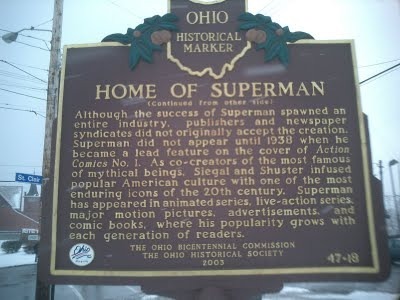 back
back
And "Siegal"? Please fix.
The Shuster Studio: Euclid Avenue between E. 105 and E.101. No longer standing.
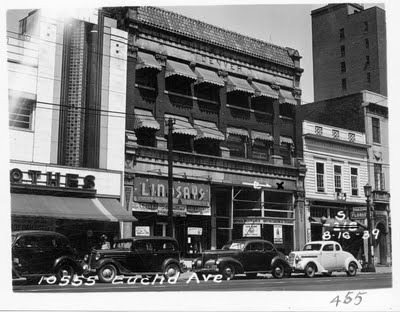 Joe's studio was in the far right building of this 1939 photo;
Joe's studio was in the far right building of this 1939 photo;
today, this area is a hospital complex.
Downtown:
The Bell/SBC Building. At one time alleged to be the model for the Daily Planet, though Joe dismissed this in his later years.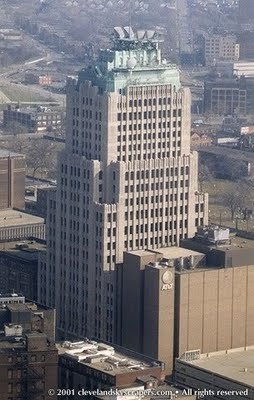 Cleveland Public Library. Joe and Jerry took the streetcar there almost every weekend. They were both voracious readers.Newspaper Enterprise Association cartoon offices in Lakeside Place, West Third Street. Now mostly legal offices, this was the syndicate that published the daily Superman strip.
Cleveland Public Library. Joe and Jerry took the streetcar there almost every weekend. They were both voracious readers.Newspaper Enterprise Association cartoon offices in Lakeside Place, West Third Street. Now mostly legal offices, this was the syndicate that published the daily Superman strip.
University Circle:
The Commodore Hotel: corner of Euclid and Ford near Case. Now an apartment building, Jerry and Joanne were married there and lived there for a time.Cleveland Museum of Art. Often cited as a place Siegel and Shuster would visit. Joe took classes at the old Cleveland School of Art.
University Heights:
Jerry's house with his first wife Bella and son, Michael: 2402 Glendon Ave. Jerry is said to have had a full-size Superman costume in the front closet to show to kids who would knock on the door and ask for Superman. The house is still a private home in a residential neighborhood.
[image error] The sites are rather scattered so a walking tour was out, and given the logistics required in organizing such a thing, it proved impractical for the hotel to take on the task.
Therefore I was thrilled to discover that Cleveland's enterprising Carol and John's Comic Shop took on the challenge. They didn't go so far as to set up a tour but did create this spiffy and thorough map to help people take a self-guided tour; they also kindly gave me permission to post it here.
[image error] My only suggestion: move the compass so it's fully visible and use the Superman S emblem not as its center but rather as the "S" for "south."
In 2008, when going down every road of promotional possibility for Boys of Steel: The Creators of Superman, I discovered that (speaking of roads) there is no Superman-themed tour of Cleveland, the city in which writer Jerry and artist Joe Shuster created him.
[image error] Joe (pointing) and Jerry (pointing)
In March 2008, I made a list of potential stops with the intention of finding someone interested in pursuing the idea. In fact, one of the big hotels in town, the Renaissance Cleveland Hotel, expressed interest in running a tour originating from their lobby, so I shared the list (since updated):
Glenville:
Jerry's house: 10622 Kimberley Avenue. Currently a private home with a commemorative Superman fence (featuring the original Superman S emblem made from stainless steel) in front.
[image error] courtesy of CapedWonder
Joe's house: No longer standing. Now an apartment/duplex at corner of Parkwood and Amor with a commemorative Superman fence (displaying a blown-up version of the first Superman story) in front.Ohio Historical Plaque: corner of E. 105 and St. Clair. The first (and, for years, only) official acknowledgment of Siegel and Shuster in Cleveland.
[image error] front
 back
backAnd "Siegal"? Please fix.
The Shuster Studio: Euclid Avenue between E. 105 and E.101. No longer standing.
 Joe's studio was in the far right building of this 1939 photo;
Joe's studio was in the far right building of this 1939 photo;today, this area is a hospital complex.
Downtown:
The Bell/SBC Building. At one time alleged to be the model for the Daily Planet, though Joe dismissed this in his later years.
 Cleveland Public Library. Joe and Jerry took the streetcar there almost every weekend. They were both voracious readers.Newspaper Enterprise Association cartoon offices in Lakeside Place, West Third Street. Now mostly legal offices, this was the syndicate that published the daily Superman strip.
Cleveland Public Library. Joe and Jerry took the streetcar there almost every weekend. They were both voracious readers.Newspaper Enterprise Association cartoon offices in Lakeside Place, West Third Street. Now mostly legal offices, this was the syndicate that published the daily Superman strip.University Circle:
The Commodore Hotel: corner of Euclid and Ford near Case. Now an apartment building, Jerry and Joanne were married there and lived there for a time.Cleveland Museum of Art. Often cited as a place Siegel and Shuster would visit. Joe took classes at the old Cleveland School of Art.
University Heights:
Jerry's house with his first wife Bella and son, Michael: 2402 Glendon Ave. Jerry is said to have had a full-size Superman costume in the front closet to show to kids who would knock on the door and ask for Superman. The house is still a private home in a residential neighborhood.
[image error] The sites are rather scattered so a walking tour was out, and given the logistics required in organizing such a thing, it proved impractical for the hotel to take on the task.
Therefore I was thrilled to discover that Cleveland's enterprising Carol and John's Comic Shop took on the challenge. They didn't go so far as to set up a tour but did create this spiffy and thorough map to help people take a self-guided tour; they also kindly gave me permission to post it here.
[image error] My only suggestion: move the compass so it's fully visible and use the Superman S emblem not as its center but rather as the "S" for "south."
Published on October 17, 2011 04:11
October 16, 2011
First-ever interview with Edward Ormondroyd, author of "David and the Phoenix," part 2 of 2
Part 1.
What was the second book you published and what was it about?
Next came The Tale of Alain, published by Follett. It was beautifully illustrated by Robert Frankenberg and showed an advance in writing skill, but I no longer care for it. It is too moralistic, a kind of secular Sunday school tract. There is no point in discussing it.
Which of your books was the hardest for you to write?
Castaways on Long Ago. I was some sixty (or was it eighty) pages into it before I realized that I had gotten off to a hopelessly wrong-footed start. I threw away the pages and began again with a little incident that becomes a leitmotif throughout the story. Things went well from then on.
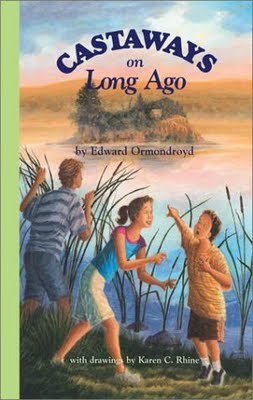 How many picture books did you publish and what are the names/subjects?
How many picture books did you publish and what are the names/subjects?
Seven. In chronological order:
Jonathan Frederick Aloysius Brown. A small boy gets separated from his mother in a crowd. When she next sees him, he is on an elephant leading the circus parade.
Michael the Upstairs Dog. A confined German Shepherd finds his way to the street. A pack of new canine buddies follows him back to his apartment where chaos ensues.
Theodore. A scruff teddy bear is mistakenly run through the wash, making him so clean that Lucy, his owner, doesn't recognize him. He takes adroit steps to render himself scruffy and recognizable again.
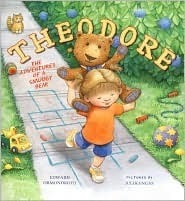 Broderick. A country mouse teaches himself to surf in a nearby lake, and with a human companion goes on to fame and fortune.
Broderick. A country mouse teaches himself to surf in a nearby lake, and with a human companion goes on to fame and fortune.
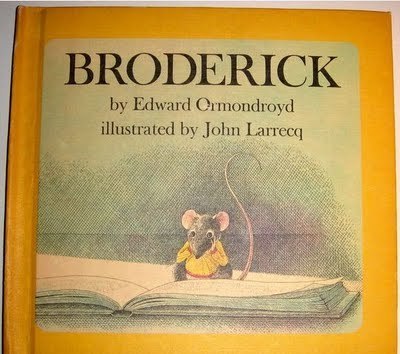 Theodore's Rival. Thinking that Lucy's new toy panda is a bear, Theodore is consumed by jealousy. Learning that he is still the bear of the family, he masterminds a thrilling rescue of the lost panda.
Theodore's Rival. Thinking that Lucy's new toy panda is a bear, Theodore is consumed by jealousy. Learning that he is still the bear of the family, he masterminds a thrilling rescue of the lost panda.
Imagination Greene. A Colonial farmboy "invents" the automobile, the telephone, and television while clowning for his younger sister. [MTN: Because of its clever premise, I bought a used copy of this out-of-print book, which was published in 1973; I was surprised to see that the back flap bio of Edward does not mention David and the Phoenix, which seems to be his most well-known book.]
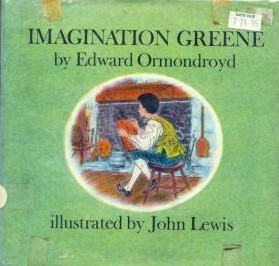 Johnny Castleseed. A boy and his father build a beautiful sandcastle by the drip method. Some spectators begin to imitate them, showing the invisible Johnny Castleseed has passed by, scattering castle seeds.
Johnny Castleseed. A boy and his father build a beautiful sandcastle by the drip method. Some spectators begin to imitate them, showing the invisible Johnny Castleseed has passed by, scattering castle seeds.
Are all of your books for young readers?
Yes, but adults can enjoy them too. I used to read a lot of terribly boring picture books to my kids and vowed that if I ever wrote picture books, the read-aloud adults would enjoy them along with their children.
Which book is your most personal and why?
Time at the Top. Absolutely. It was such a pleasure to write, maybe because I put myself in it under my own name as one of the characters. A very close second is the sequel, All in Good Time, where I again do something that advances the plot. But all my books are personal. You can't write fiction impersonally.
Did you ever consider a sequel to David and the Phoenix?
I not only considered it, I was fool enough to write it. Disaster! I threw away the whole book.
What was the sequel about? When did you write it? Did you save no copy?
Well, the Phoenix was irrevocably gone, so I substituted a gnome-like figure, and he and David set out on a quest, carried by a flying suitcase...but of course without the old Phoenix it was as useless as Gone with the Wind without Scarlett O'Hara. I can't remember when I committed this literary crime. No copy. My wastebasket is a receptacle of no return.
If at one point you stopped trying for publication, when and why?
My writing career ended some time in the early 1970s when I realized that the reason I was so hopelessly bogged down in a new book was because the gift of invention had left me, and it was time to get a day job. Fortunately, one was waiting for me.
What was it?
Joan and I had come to Ithaca, NY by then. In 1973 or '74 I applied for and got a job as Head of Technical Services in the Finger Lakes Library System.
Which, if any, of your out-of-print books would you like to see reissued? Is it the one you see as most commercial to a modern readership?
Castaways on Long Ago has been reissued by Green Mansion Press. Purple House Press has reissued Time at the Top in addition to David and the Phoenix. A dramatic reading of the latter is available from Full Cast Audio: I read the narrative and actors read the dialog. The first reissue of Time at the Top has sold out, so Purple House Press plans to reissue it again along with its sequel All in Good Time in one volume this fall. Dial Books for Young Readers reissued Theodore with colorful new illustrations, then abandoned it when the economic meltdown left it dead in the water. I would like to see Theodore, Theodore's Rival, and Broderick reissued, but don't have any expectations that it will happen.
Do you read any fantasy novels of today?
I don't seek them out as such. This question led me to the realization that some of my favorite novels are indeed fantasies: Norman Douglas's South Wind, David Foster Wallace's Infinite Jest, Peter Carey's My Life as a Fake, Nabakov's Pale Fire.
Have you ever spoken in schools?
Well, I've read two of my picture books to gratify my grandson Connor (and his kindergarten teacher) and once at the instance of my wife who volunteers as a teacher's assistant in a local grammar school.
Please tell me about your wife and children.
Joan and I met when we were both working for the Contra Costa County Library System in California. She had four children and I had three. They are all grown now and living on the west coast, to our sorrow: Karen, a psychotherapist; Jeff an agroecologist and consultant in carbon sequestration; Evan, an architectural and industrial model maker; Gordie, a construction contractor; Claire, a lawyer working for the county personnel department; Aster, an events coordinator; and Beth, a quilter.
Our grandchildren are Brian, who is in college studying architecture; Connor, who just graduated from high school and wants to be a wilderness educator, and Jade, who is in middle school, plays cello, and has distinct artistic abilities.
Where do you live?
Trumansburg, NY, in the heart of the Finger Lakes region, one of the most beautiful landscapes in America.
Do people in your community know you are an author?
Some do, probably most don't.
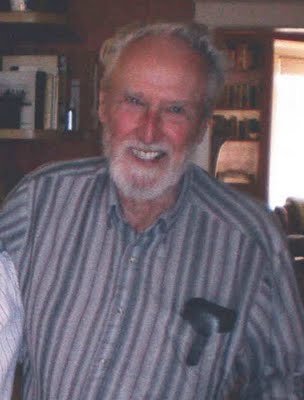 Edward today
Edward today
When was the last time you were asked to speak or appear as an author at an event?
Approximately forty years ago. I told a group of children's librarians the story of David and the Phoenix—inception, wandering in the wilderness, publication. I learned a little later that what they had wanted to hear about was Time at the Top. And so it goes (as Kurt Vonnegut was so fond of saying).
Have you saved any articles that have been published about you, and if so, when/where are they from?
I'm not aware of any article having been published about me, but a lovely one was published about David and the Phoenix. It was published in 2009 by Roaring Book Press in a book titled Everything I Need to Know I Learned from a Children's Book. People from all walks of life tell about the children's book that meant the most to them. The essay on David and the Phoenix was written by Professor Gerald Early of Washington University and contains the most flattering words and author can hear: "After I finished reading it, I immediately reread it."
What interests/activities occupy you these days?
Gardening, practicing piano, trying to keep up with the too-many periodicals we subscribe to, reading new books and rereading old favorites, birdwatching, walking, concert-going. Joan sees to it that we have a lively social life.
How are you feeling?
My joints creak, my bones ache, my vision and hearing are declining—but I feel great!
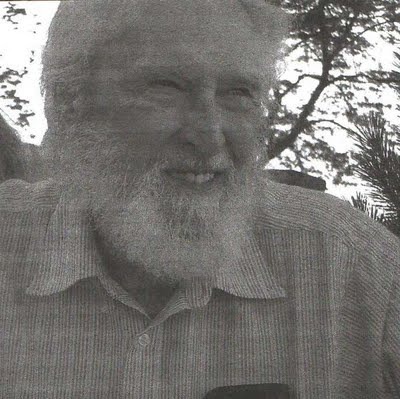 Are you still writing, and if so, what about?
Are you still writing, and if so, what about?
I've made some stabs at it—a couple of poems, memoir-essays—but my discipline is not what it was.
What was your reaction when you learned why I was contacting you?
I was overawed when you introduced yourself as the author of some 70 books. I was intrigued, too. Although I am computer-illiterate I know about blogs, but never dreamed of actually appearing in one.
How do you want people to remember you?
You know, I hadn't even thought about this until you asked. On reflection, I'll take a cue from Marianne Moore. As a writer I'd like to be remembered as a maker of imaginary worlds with real characters in them.
Is there anything you'd like to add?
Lots, but I'm tired. Aren't you?
What was the second book you published and what was it about?
Next came The Tale of Alain, published by Follett. It was beautifully illustrated by Robert Frankenberg and showed an advance in writing skill, but I no longer care for it. It is too moralistic, a kind of secular Sunday school tract. There is no point in discussing it.
Which of your books was the hardest for you to write?
Castaways on Long Ago. I was some sixty (or was it eighty) pages into it before I realized that I had gotten off to a hopelessly wrong-footed start. I threw away the pages and began again with a little incident that becomes a leitmotif throughout the story. Things went well from then on.
 How many picture books did you publish and what are the names/subjects?
How many picture books did you publish and what are the names/subjects? Seven. In chronological order:
Jonathan Frederick Aloysius Brown. A small boy gets separated from his mother in a crowd. When she next sees him, he is on an elephant leading the circus parade.
Michael the Upstairs Dog. A confined German Shepherd finds his way to the street. A pack of new canine buddies follows him back to his apartment where chaos ensues.
Theodore. A scruff teddy bear is mistakenly run through the wash, making him so clean that Lucy, his owner, doesn't recognize him. He takes adroit steps to render himself scruffy and recognizable again.
 Broderick. A country mouse teaches himself to surf in a nearby lake, and with a human companion goes on to fame and fortune.
Broderick. A country mouse teaches himself to surf in a nearby lake, and with a human companion goes on to fame and fortune. Theodore's Rival. Thinking that Lucy's new toy panda is a bear, Theodore is consumed by jealousy. Learning that he is still the bear of the family, he masterminds a thrilling rescue of the lost panda.
Theodore's Rival. Thinking that Lucy's new toy panda is a bear, Theodore is consumed by jealousy. Learning that he is still the bear of the family, he masterminds a thrilling rescue of the lost panda.Imagination Greene. A Colonial farmboy "invents" the automobile, the telephone, and television while clowning for his younger sister. [MTN: Because of its clever premise, I bought a used copy of this out-of-print book, which was published in 1973; I was surprised to see that the back flap bio of Edward does not mention David and the Phoenix, which seems to be his most well-known book.]
 Johnny Castleseed. A boy and his father build a beautiful sandcastle by the drip method. Some spectators begin to imitate them, showing the invisible Johnny Castleseed has passed by, scattering castle seeds.
Johnny Castleseed. A boy and his father build a beautiful sandcastle by the drip method. Some spectators begin to imitate them, showing the invisible Johnny Castleseed has passed by, scattering castle seeds.Are all of your books for young readers?
Yes, but adults can enjoy them too. I used to read a lot of terribly boring picture books to my kids and vowed that if I ever wrote picture books, the read-aloud adults would enjoy them along with their children.
Which book is your most personal and why?
Time at the Top. Absolutely. It was such a pleasure to write, maybe because I put myself in it under my own name as one of the characters. A very close second is the sequel, All in Good Time, where I again do something that advances the plot. But all my books are personal. You can't write fiction impersonally.
Did you ever consider a sequel to David and the Phoenix?
I not only considered it, I was fool enough to write it. Disaster! I threw away the whole book.
What was the sequel about? When did you write it? Did you save no copy?
Well, the Phoenix was irrevocably gone, so I substituted a gnome-like figure, and he and David set out on a quest, carried by a flying suitcase...but of course without the old Phoenix it was as useless as Gone with the Wind without Scarlett O'Hara. I can't remember when I committed this literary crime. No copy. My wastebasket is a receptacle of no return.
If at one point you stopped trying for publication, when and why?
My writing career ended some time in the early 1970s when I realized that the reason I was so hopelessly bogged down in a new book was because the gift of invention had left me, and it was time to get a day job. Fortunately, one was waiting for me.
What was it?
Joan and I had come to Ithaca, NY by then. In 1973 or '74 I applied for and got a job as Head of Technical Services in the Finger Lakes Library System.
Which, if any, of your out-of-print books would you like to see reissued? Is it the one you see as most commercial to a modern readership?
Castaways on Long Ago has been reissued by Green Mansion Press. Purple House Press has reissued Time at the Top in addition to David and the Phoenix. A dramatic reading of the latter is available from Full Cast Audio: I read the narrative and actors read the dialog. The first reissue of Time at the Top has sold out, so Purple House Press plans to reissue it again along with its sequel All in Good Time in one volume this fall. Dial Books for Young Readers reissued Theodore with colorful new illustrations, then abandoned it when the economic meltdown left it dead in the water. I would like to see Theodore, Theodore's Rival, and Broderick reissued, but don't have any expectations that it will happen.
Do you read any fantasy novels of today?
I don't seek them out as such. This question led me to the realization that some of my favorite novels are indeed fantasies: Norman Douglas's South Wind, David Foster Wallace's Infinite Jest, Peter Carey's My Life as a Fake, Nabakov's Pale Fire.
Have you ever spoken in schools?
Well, I've read two of my picture books to gratify my grandson Connor (and his kindergarten teacher) and once at the instance of my wife who volunteers as a teacher's assistant in a local grammar school.
Please tell me about your wife and children.
Joan and I met when we were both working for the Contra Costa County Library System in California. She had four children and I had three. They are all grown now and living on the west coast, to our sorrow: Karen, a psychotherapist; Jeff an agroecologist and consultant in carbon sequestration; Evan, an architectural and industrial model maker; Gordie, a construction contractor; Claire, a lawyer working for the county personnel department; Aster, an events coordinator; and Beth, a quilter.
Our grandchildren are Brian, who is in college studying architecture; Connor, who just graduated from high school and wants to be a wilderness educator, and Jade, who is in middle school, plays cello, and has distinct artistic abilities.
Where do you live?
Trumansburg, NY, in the heart of the Finger Lakes region, one of the most beautiful landscapes in America.
Do people in your community know you are an author?
Some do, probably most don't.
 Edward today
Edward todayWhen was the last time you were asked to speak or appear as an author at an event?
Approximately forty years ago. I told a group of children's librarians the story of David and the Phoenix—inception, wandering in the wilderness, publication. I learned a little later that what they had wanted to hear about was Time at the Top. And so it goes (as Kurt Vonnegut was so fond of saying).
Have you saved any articles that have been published about you, and if so, when/where are they from?
I'm not aware of any article having been published about me, but a lovely one was published about David and the Phoenix. It was published in 2009 by Roaring Book Press in a book titled Everything I Need to Know I Learned from a Children's Book. People from all walks of life tell about the children's book that meant the most to them. The essay on David and the Phoenix was written by Professor Gerald Early of Washington University and contains the most flattering words and author can hear: "After I finished reading it, I immediately reread it."
What interests/activities occupy you these days?
Gardening, practicing piano, trying to keep up with the too-many periodicals we subscribe to, reading new books and rereading old favorites, birdwatching, walking, concert-going. Joan sees to it that we have a lively social life.
How are you feeling?
My joints creak, my bones ache, my vision and hearing are declining—but I feel great!
 Are you still writing, and if so, what about?
Are you still writing, and if so, what about?I've made some stabs at it—a couple of poems, memoir-essays—but my discipline is not what it was.
What was your reaction when you learned why I was contacting you?
I was overawed when you introduced yourself as the author of some 70 books. I was intrigued, too. Although I am computer-illiterate I know about blogs, but never dreamed of actually appearing in one.
How do you want people to remember you?
You know, I hadn't even thought about this until you asked. On reflection, I'll take a cue from Marianne Moore. As a writer I'd like to be remembered as a maker of imaginary worlds with real characters in them.
Is there anything you'd like to add?
Lots, but I'm tired. Aren't you?
Published on October 16, 2011 00:00
October 15, 2011
First-ever interview with Edward Ormondroyd, author of "David and the Phoenix," part 1 of 2
As a boy, I read and loved a novel called David and the Phoenix.
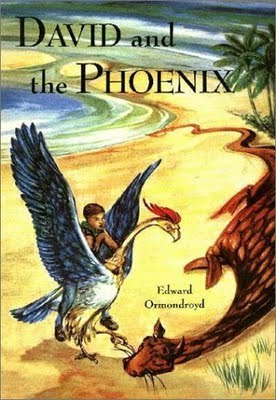 A few years into my professional writing career, I rediscovered the book, which had recently been reissued by Purple House Press.
A few years into my professional writing career, I rediscovered the book, which had recently been reissued by Purple House Press.
Much more recently, I discovered the author himself, the charming Edward Ormondroyd. After several attempts, I managed to get his attention and asked if I could interview him.
I continue to be surprised whenever I find that someone whose work I loved in a younger day has almost no or literally no online presence—barely a photo and nary an interview. But then I get excited because it means maybe I can be the one to help change that.
As is the case here. For Edward kindly agreed to an interview and generously shared a richer tableau than I could've rightfully asked. (Then again, I did ask a lot, to which Edward wrote "Cry you mercy, sir! Forty-one questions!")
Here are his (approximately) 41 answers (among them, another reminder that a rejection is not always the end):
When and where were you born? Where did you grow up?
1925. Wilkinsburg, PA. From age 5 to 12, Swarthmore, PA. From 12 through high school, Ann Arbor, MI. I'm still growing up...I hope.
What was your childhood like?
Suburban, mildly affluent, for the most part idyllic. In those Depression days children were not densely scheduled as they now seem to be. Once chores (lawn mowing, carrying out the garbage, weeding) were done, I was free to roam with my friends through a landscape much more accessible than any comparable one now.
Did you have a favorite book as a child?
I loved so many that it is impossible to pick a favorite. All of A.A. Milne. Kipling's Jungle books and Just So Stories. Treasure Island and A Child's Garden of Verses. Heidi. Tom Sawyer and Huckleberry Finn. Later I came under the spell of Arthur Ransome—in fact, I'm still under his spell.
What kind of student were you?
Pretty backward in arithmetic, but pretty adept in other subjects. When math became more interesting, at the algebra stage, I began to catch on and catch up. I was a dud in sports (but a good swimmer).
What were your feelings about serving in WWII? Did you see combat?
I couldn't wait to join up. It wasn't patriotism so much as allure of a great adventure. I joined the Navy as soon after high school as I could (1943). It was an intense learning experience for a well-bred, well-educated, sheltered boy to be thrown in with roughs and rowdies, Southerners still sore about losing the Civil War, older men, kids from the working class, from farms, from big cities. And I loved being at sea.
I never saw combat in the sense of being involved in the great Pacific naval battles, but my ship, a destroyer escort, was close astern an aircraft carrier when the carrier was hit by a kamikaze and caught on fire. The fire could not be controlled and the ship had to be abandoned after the aviation gasoline and ammunition locker exploded. I was on the bridge as a scared and horrified witness of the whole disaster. It was enough action to last me a lifetime.
What was your college experience?
I was one of the horde of veterans that poured into UC Berkeley on the GI Bill. The administration had to set up a circus tent to process us through and the line of applicants snaked around several city blocks. I majored in English literature. I was so hungry to know that I wanted to take every course in the catalog. Except for an intense spell of depression, for which I could not account (nor can I now), I had an exciting and enjoyable freshman year.
As a sophomore I acquired two roommates, a physics major and a public health major who was a refugee from wartime Vienna. We rented a third-floor apartment, sharing the rent of—hold on to your chair—$32.50. We called the place Heaven's Cellar. We did our own cooking, most of it edible, and lived very well on our government stipends of $65 a month. We even had jug wine (one dollar a gallon) with dinners and thought ourselves immensely sophisticated. I later returned to library school at Berkeley and took an MLS degree.
Folk songs were all the rage; it was the time of Burl Ives, Richard Dyer-Bennett, John Jacob Niles. Classical music was a shared interest, too. I joined the staff of the campus literary magazine and published a story and a poem. Of course went to the home football games to cheer the team, whistle and howl at the drum majorettes, and make indelicate gestures at our opponents, especially Stanford. It was one of the happiest times of my life.
What was your first job after college?
Nothing in my education prepared me for a white-collar job and I had no interest in becoming a member of academe. The chronology of my work experience is hopelessly mixed up in my memory but my first job was in a paper processing plant, one of the many small factories in the western end of Berkeley. I learned to operate a cutting machine and joined a union. Later I clerked in a bookstore. I thought of it all as a way of subsidizing my career as a writer. I was writing not-very-good stories and keeping a journal. I learned to play the recorder, which in later years led to a position in a Renaissance band. A shortage of sailors led me to ship out for a time as an AB seaman with Standard Oil—tanker runs from the refineries of Richmond to Alaska and Hawaii. This was so lucrative that I could live on my savings for long periods without working at all. It will be no surprise that after library school I got a job as a librarian.
When did you realize you'd like to write books?
By the end of high school I knew I wanted to write—but I didn't know what to write about. The idea of writing a book, let alone a children's book, didn't occur to me until I found myself composing David and the Phoenix in college. I'm still surprised that it happened. It was as if the choice made me rather than the other way around.
What inspired you to write David and the Phoenix?
As I explain in the foreword to the reprint of David and the Phoenix by Purple House Press, I was walking on the Berkeley campus when a vision flashed in my mind of a large bird hurling itself out of an upstairs window and becoming entangled in a rose arbor below. It's a complete mystery to me where that came from. Alpha Centauri, perhaps? That the bird might be the Phoenix might have been suggested by a scene in T.H. White's The Sword in the Stone, which I had just read. I was familiar with the Phoenix legend [i.e. that there is only one at a time]. My bird's character may have been suggested by Major Hoople, a fat and pompous character in a newspaper cartoon called Our Boarding House. Perhaps the notion of David riding the Phoenix's back came from The Wonderful Adventures of Nils by Selma Lagerlöf, in which a very small boy is carried to various adventures on the back of a goose.
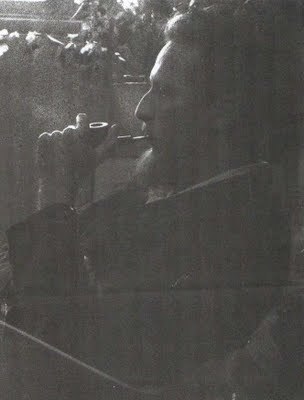 Edward circa 1960 (he doesn't have a clearer photo from the period)
Edward circa 1960 (he doesn't have a clearer photo from the period)
I know it was your first published book but was it the first book you wrote with the intention of publication?
Thereby hangs a tale of coincidence, mystery, and irony. I wasn't consciously thinking of publication when I began David and the Phoenix. An intriguing idea had come to me and I was having fun seeing what I could do with it. I think my main motive was to amuse two dear friends, Shirley and Josh, who eventually became the dedicatees. Of course, publication did become a goal as I proceeded, but I was totally in the dark as to how one achieved it. At last, here was this thick completed manuscript—now what?
Here's the coincidence part. Just about this time I somehow learned that Follett Publishing Company in Chicago was launching a contest: previously unpublished writers could submit their juvenile manuscripts and the winner would not only be published but awarded a substantial cash prize. I sent in my book, and after a long period of hopes and fears, got it back with blandly-worded regrets.
Now began the seven-year period that I think of as the years wandering in the wilderness. I didn't know that I could have gone to the public library to be supplied with a plethora of publishing information—names and addresses. So yet again it was…now what?
Not long after the return of my book, I got a very nice note from a very nice lady. (Would that I could remember her name, to thank her or her memory for this kindness and a later one.) She said that she had been on the panel of judges for the Follett contest, had liked my book very much, and wanted to see it published; send it to—and she gave me the names and addresses of some juvenile editors. I thanked her and duly sent off the manuscript to the suggested editors. It was duly rejected by each one.
At a party I met a young lady who told me she was off to New York shortly in the hopes of becoming a literary agent. "Exactly what I need!" I said. She read my story, said she loved it, and set off. And vanished. She never got in touch with me, I didn't know how to get in touch with her, and the rest, as they say, is silence.
Then there was the delivery service. It didn't attempt to sell your book but for a fee would deliver it to three publishers' offices. I retype the manuscript from the carbon copy and sent it off. A very long silence, at the end of which I wrote to ask what was up. The apologetic answer: they had lost the manuscript.
While poor David and the Phoenix wandered in the wilderness, I was busy writing between or during jobs. Having written a children's book was all very well, but I thought a real writer's goal should be the Great American Novel. I went through a lot of literary turmoil to discover that I didn't have the chops for the Great American Novel, or even an ordinary American novel.
Then something amazing happened. Years after her first note, the very kind lady wrote me another. She said she had been waiting a long time for my book's appearance on some publisher's list and was disappointed not to find it. [She recommended some agents and I selected one at random.] It was the turnaround moment.
Muriel Fuller knew her stuff and had a great sense of humor. She liked David and the Phoenix, I liked her, and we were in business forthwith. She began collecting rejections, too, but because she could talk directly to editors she also began to get valuable suggestions. The most cogent was that the manuscript was too long. She agreed. I probably balked at first but was finally persuaded to get out my chainsaw and scalpel. The story was cut by at least a third and I had to admit that the leaner version was the better one.
Ms. Fuller finally sold it—to Follett, the very first publisher to have rejected it seven years before. Not only that, she placed it in a Sunday school magazine for children, name and denomination now forgotten. Best of all, she sold it to the Weekly Reader Book Club.
By chance do you still have the rejection letters?
I collected them for a while, then discarded them all. There was nothing to be learned from their bland, [similar] wording. [They were] printed up in advance, of course, and I can understand and appreciate why. Still, if some editor had scrawled on a scrap of paper "We don't like your story and wouldn't dream of publishing it," I would not only have saved the letter, I would have framed it!
Which job from the list above was your day job while writing David and the Phoenix?
I believe most or all of it was written while I was being supported by the GI Bill. Sorry to be so vague, but it all happened more than half a century ago.
Do you remember how long the book took you to write?
It was not written in a single stretch of time. Other matters intervened at least twice. Let's say, all in all, about six months. A major revision made at one editor's suggestion must have taken another month, at least, because all the decisions I had to make were not easy.
Did you write it longhand or by typewriter?
I wrote it in longhand first ([probably pencil because the first ballpoint pens were so frustratingly unreliable) and then typed it up when the cross-outs, interlineations, and marginal additions threatened to make the whole page incoherent even to me. Of course, the typed version would be put through many revisions, too. I wrote all my books this way.
Do you remember how you reacted when you learned it would be published?
No, but I must have been elated after all those years of wandering in the wilderness. I think I also had a naive conviction that I was on the brink of fame and fortune.
Did you do signings or other appearances to promote the book?
No, in those days it was the publisher's job to promote a book, not the author's. I have since done signings but under only the most local of circumstances, and not in the interest of promotion.
What was the reception to David and the Phoenix from reviewers, teachers, kids?
I never read any reviews of the book—they were published in newspapers and periodicals that I didn't subscribe to or didn't even know about. No one clipped them out to send to me. The local Bay Area reviews must have been positive because the Commonwealth Club of California awarded me a silver medal for the best juvenile of 1957. I had to give a speech at their annual literary awards dinner. (Terrifying!)
I began to hear from teachers, and occasionally still do, who enjoyed reading it to their pupils, whose letters they would include along with their own. The most heartening responses are from now-middle-aged readers who tell me how much they loved it as kids, and how much they look forward to sharing it with grandchildren, nieces. and nephews.
Was there ever talk of turning David and the Phoenix into a film? If so, what happened? If not, would you like that?
Oh yes, lots of talk, mostly by graduates of film school who fantasized about making a film but didn't have the necessary contacts in the industry. Ten years or so after publication, a caricature of a Hollywood [producer called and] offered me $10,000 for the rights. "Ask for more," a friend suggested. I did, and that was the end of that. I might have suspected a put-on except none of my friends would have been capable of such a prank.
The [following] story is so amusing that my wife Joan still tells it to general hilarity at dinner parties. Disney wanted to make it into [one of] its trademark animated cartoon[s]. [When they first called, Joan thought it was a promotional call for Disneyland, said "We're not interested," and hung up. The Disney person, now puzzled, called back and said they wanted to make a movie.]
The money on offer was, by industry standards, stingy. [Plus] Jill Morgan, my new publisher at Purple House Press, and I simply didn't like what Disney does with its "properties." On the very brink of the deadline, a young man burst on the scene begging us not to sign with Disney. He had loved David and the Phoenix since he was a boy and was determined to organize a film himself and do it true to the story. He was in the industry and had plenty of contacts. So convincing was he that we told Disney no and gave him our blessing.
He has aroused a lot of interest wherever he's taken it, but at the end of seven years has still not found someone to put up the money. I would like a film to be made, but only if the spirit of the book is kept in the transition.
As a coda, a more upbeat story: Bruce Coville formed a company called Full Cast Audio to record dramatic readings of children's books in which the author reads the narrative parts and actors read the dialogue. He invited me to record David and the Phoenix. It was a fascinating—and exhausting—process. The company has since succumbed to the economic downturn, but the recording is still available, and occasionally outsells the book itself.
By the way, my favorite of my books, Time at the Top, was made into a movie for TV by Showtime. When I read the script, I was so appalled at what had been done to my beloved story that I have never been able to bring myself to watch it.
Part 2.

 A few years into my professional writing career, I rediscovered the book, which had recently been reissued by Purple House Press.
A few years into my professional writing career, I rediscovered the book, which had recently been reissued by Purple House Press. Much more recently, I discovered the author himself, the charming Edward Ormondroyd. After several attempts, I managed to get his attention and asked if I could interview him.
I continue to be surprised whenever I find that someone whose work I loved in a younger day has almost no or literally no online presence—barely a photo and nary an interview. But then I get excited because it means maybe I can be the one to help change that.
As is the case here. For Edward kindly agreed to an interview and generously shared a richer tableau than I could've rightfully asked. (Then again, I did ask a lot, to which Edward wrote "Cry you mercy, sir! Forty-one questions!")
Here are his (approximately) 41 answers (among them, another reminder that a rejection is not always the end):
When and where were you born? Where did you grow up?
1925. Wilkinsburg, PA. From age 5 to 12, Swarthmore, PA. From 12 through high school, Ann Arbor, MI. I'm still growing up...I hope.
What was your childhood like?
Suburban, mildly affluent, for the most part idyllic. In those Depression days children were not densely scheduled as they now seem to be. Once chores (lawn mowing, carrying out the garbage, weeding) were done, I was free to roam with my friends through a landscape much more accessible than any comparable one now.
Did you have a favorite book as a child?
I loved so many that it is impossible to pick a favorite. All of A.A. Milne. Kipling's Jungle books and Just So Stories. Treasure Island and A Child's Garden of Verses. Heidi. Tom Sawyer and Huckleberry Finn. Later I came under the spell of Arthur Ransome—in fact, I'm still under his spell.
What kind of student were you?
Pretty backward in arithmetic, but pretty adept in other subjects. When math became more interesting, at the algebra stage, I began to catch on and catch up. I was a dud in sports (but a good swimmer).
What were your feelings about serving in WWII? Did you see combat?
I couldn't wait to join up. It wasn't patriotism so much as allure of a great adventure. I joined the Navy as soon after high school as I could (1943). It was an intense learning experience for a well-bred, well-educated, sheltered boy to be thrown in with roughs and rowdies, Southerners still sore about losing the Civil War, older men, kids from the working class, from farms, from big cities. And I loved being at sea.
I never saw combat in the sense of being involved in the great Pacific naval battles, but my ship, a destroyer escort, was close astern an aircraft carrier when the carrier was hit by a kamikaze and caught on fire. The fire could not be controlled and the ship had to be abandoned after the aviation gasoline and ammunition locker exploded. I was on the bridge as a scared and horrified witness of the whole disaster. It was enough action to last me a lifetime.
What was your college experience?
I was one of the horde of veterans that poured into UC Berkeley on the GI Bill. The administration had to set up a circus tent to process us through and the line of applicants snaked around several city blocks. I majored in English literature. I was so hungry to know that I wanted to take every course in the catalog. Except for an intense spell of depression, for which I could not account (nor can I now), I had an exciting and enjoyable freshman year.
As a sophomore I acquired two roommates, a physics major and a public health major who was a refugee from wartime Vienna. We rented a third-floor apartment, sharing the rent of—hold on to your chair—$32.50. We called the place Heaven's Cellar. We did our own cooking, most of it edible, and lived very well on our government stipends of $65 a month. We even had jug wine (one dollar a gallon) with dinners and thought ourselves immensely sophisticated. I later returned to library school at Berkeley and took an MLS degree.
Folk songs were all the rage; it was the time of Burl Ives, Richard Dyer-Bennett, John Jacob Niles. Classical music was a shared interest, too. I joined the staff of the campus literary magazine and published a story and a poem. Of course went to the home football games to cheer the team, whistle and howl at the drum majorettes, and make indelicate gestures at our opponents, especially Stanford. It was one of the happiest times of my life.
What was your first job after college?
Nothing in my education prepared me for a white-collar job and I had no interest in becoming a member of academe. The chronology of my work experience is hopelessly mixed up in my memory but my first job was in a paper processing plant, one of the many small factories in the western end of Berkeley. I learned to operate a cutting machine and joined a union. Later I clerked in a bookstore. I thought of it all as a way of subsidizing my career as a writer. I was writing not-very-good stories and keeping a journal. I learned to play the recorder, which in later years led to a position in a Renaissance band. A shortage of sailors led me to ship out for a time as an AB seaman with Standard Oil—tanker runs from the refineries of Richmond to Alaska and Hawaii. This was so lucrative that I could live on my savings for long periods without working at all. It will be no surprise that after library school I got a job as a librarian.
When did you realize you'd like to write books?
By the end of high school I knew I wanted to write—but I didn't know what to write about. The idea of writing a book, let alone a children's book, didn't occur to me until I found myself composing David and the Phoenix in college. I'm still surprised that it happened. It was as if the choice made me rather than the other way around.
What inspired you to write David and the Phoenix?
As I explain in the foreword to the reprint of David and the Phoenix by Purple House Press, I was walking on the Berkeley campus when a vision flashed in my mind of a large bird hurling itself out of an upstairs window and becoming entangled in a rose arbor below. It's a complete mystery to me where that came from. Alpha Centauri, perhaps? That the bird might be the Phoenix might have been suggested by a scene in T.H. White's The Sword in the Stone, which I had just read. I was familiar with the Phoenix legend [i.e. that there is only one at a time]. My bird's character may have been suggested by Major Hoople, a fat and pompous character in a newspaper cartoon called Our Boarding House. Perhaps the notion of David riding the Phoenix's back came from The Wonderful Adventures of Nils by Selma Lagerlöf, in which a very small boy is carried to various adventures on the back of a goose.
 Edward circa 1960 (he doesn't have a clearer photo from the period)
Edward circa 1960 (he doesn't have a clearer photo from the period)I know it was your first published book but was it the first book you wrote with the intention of publication?
Thereby hangs a tale of coincidence, mystery, and irony. I wasn't consciously thinking of publication when I began David and the Phoenix. An intriguing idea had come to me and I was having fun seeing what I could do with it. I think my main motive was to amuse two dear friends, Shirley and Josh, who eventually became the dedicatees. Of course, publication did become a goal as I proceeded, but I was totally in the dark as to how one achieved it. At last, here was this thick completed manuscript—now what?
Here's the coincidence part. Just about this time I somehow learned that Follett Publishing Company in Chicago was launching a contest: previously unpublished writers could submit their juvenile manuscripts and the winner would not only be published but awarded a substantial cash prize. I sent in my book, and after a long period of hopes and fears, got it back with blandly-worded regrets.
Now began the seven-year period that I think of as the years wandering in the wilderness. I didn't know that I could have gone to the public library to be supplied with a plethora of publishing information—names and addresses. So yet again it was…now what?
Not long after the return of my book, I got a very nice note from a very nice lady. (Would that I could remember her name, to thank her or her memory for this kindness and a later one.) She said that she had been on the panel of judges for the Follett contest, had liked my book very much, and wanted to see it published; send it to—and she gave me the names and addresses of some juvenile editors. I thanked her and duly sent off the manuscript to the suggested editors. It was duly rejected by each one.
At a party I met a young lady who told me she was off to New York shortly in the hopes of becoming a literary agent. "Exactly what I need!" I said. She read my story, said she loved it, and set off. And vanished. She never got in touch with me, I didn't know how to get in touch with her, and the rest, as they say, is silence.
Then there was the delivery service. It didn't attempt to sell your book but for a fee would deliver it to three publishers' offices. I retype the manuscript from the carbon copy and sent it off. A very long silence, at the end of which I wrote to ask what was up. The apologetic answer: they had lost the manuscript.
While poor David and the Phoenix wandered in the wilderness, I was busy writing between or during jobs. Having written a children's book was all very well, but I thought a real writer's goal should be the Great American Novel. I went through a lot of literary turmoil to discover that I didn't have the chops for the Great American Novel, or even an ordinary American novel.
Then something amazing happened. Years after her first note, the very kind lady wrote me another. She said she had been waiting a long time for my book's appearance on some publisher's list and was disappointed not to find it. [She recommended some agents and I selected one at random.] It was the turnaround moment.
Muriel Fuller knew her stuff and had a great sense of humor. She liked David and the Phoenix, I liked her, and we were in business forthwith. She began collecting rejections, too, but because she could talk directly to editors she also began to get valuable suggestions. The most cogent was that the manuscript was too long. She agreed. I probably balked at first but was finally persuaded to get out my chainsaw and scalpel. The story was cut by at least a third and I had to admit that the leaner version was the better one.
Ms. Fuller finally sold it—to Follett, the very first publisher to have rejected it seven years before. Not only that, she placed it in a Sunday school magazine for children, name and denomination now forgotten. Best of all, she sold it to the Weekly Reader Book Club.
By chance do you still have the rejection letters?
I collected them for a while, then discarded them all. There was nothing to be learned from their bland, [similar] wording. [They were] printed up in advance, of course, and I can understand and appreciate why. Still, if some editor had scrawled on a scrap of paper "We don't like your story and wouldn't dream of publishing it," I would not only have saved the letter, I would have framed it!
Which job from the list above was your day job while writing David and the Phoenix?
I believe most or all of it was written while I was being supported by the GI Bill. Sorry to be so vague, but it all happened more than half a century ago.
Do you remember how long the book took you to write?
It was not written in a single stretch of time. Other matters intervened at least twice. Let's say, all in all, about six months. A major revision made at one editor's suggestion must have taken another month, at least, because all the decisions I had to make were not easy.
Did you write it longhand or by typewriter?
I wrote it in longhand first ([probably pencil because the first ballpoint pens were so frustratingly unreliable) and then typed it up when the cross-outs, interlineations, and marginal additions threatened to make the whole page incoherent even to me. Of course, the typed version would be put through many revisions, too. I wrote all my books this way.
Do you remember how you reacted when you learned it would be published?
No, but I must have been elated after all those years of wandering in the wilderness. I think I also had a naive conviction that I was on the brink of fame and fortune.
Did you do signings or other appearances to promote the book?
No, in those days it was the publisher's job to promote a book, not the author's. I have since done signings but under only the most local of circumstances, and not in the interest of promotion.
What was the reception to David and the Phoenix from reviewers, teachers, kids?
I never read any reviews of the book—they were published in newspapers and periodicals that I didn't subscribe to or didn't even know about. No one clipped them out to send to me. The local Bay Area reviews must have been positive because the Commonwealth Club of California awarded me a silver medal for the best juvenile of 1957. I had to give a speech at their annual literary awards dinner. (Terrifying!)
I began to hear from teachers, and occasionally still do, who enjoyed reading it to their pupils, whose letters they would include along with their own. The most heartening responses are from now-middle-aged readers who tell me how much they loved it as kids, and how much they look forward to sharing it with grandchildren, nieces. and nephews.
Was there ever talk of turning David and the Phoenix into a film? If so, what happened? If not, would you like that?
Oh yes, lots of talk, mostly by graduates of film school who fantasized about making a film but didn't have the necessary contacts in the industry. Ten years or so after publication, a caricature of a Hollywood [producer called and] offered me $10,000 for the rights. "Ask for more," a friend suggested. I did, and that was the end of that. I might have suspected a put-on except none of my friends would have been capable of such a prank.
The [following] story is so amusing that my wife Joan still tells it to general hilarity at dinner parties. Disney wanted to make it into [one of] its trademark animated cartoon[s]. [When they first called, Joan thought it was a promotional call for Disneyland, said "We're not interested," and hung up. The Disney person, now puzzled, called back and said they wanted to make a movie.]
The money on offer was, by industry standards, stingy. [Plus] Jill Morgan, my new publisher at Purple House Press, and I simply didn't like what Disney does with its "properties." On the very brink of the deadline, a young man burst on the scene begging us not to sign with Disney. He had loved David and the Phoenix since he was a boy and was determined to organize a film himself and do it true to the story. He was in the industry and had plenty of contacts. So convincing was he that we told Disney no and gave him our blessing.
He has aroused a lot of interest wherever he's taken it, but at the end of seven years has still not found someone to put up the money. I would like a film to be made, but only if the spirit of the book is kept in the transition.
As a coda, a more upbeat story: Bruce Coville formed a company called Full Cast Audio to record dramatic readings of children's books in which the author reads the narrative parts and actors read the dialogue. He invited me to record David and the Phoenix. It was a fascinating—and exhausting—process. The company has since succumbed to the economic downturn, but the recording is still available, and occasionally outsells the book itself.
By the way, my favorite of my books, Time at the Top, was made into a movie for TV by Showtime. When I read the script, I was so appalled at what had been done to my beloved story that I have never been able to bring myself to watch it.
Part 2.
Published on October 15, 2011 01:09



